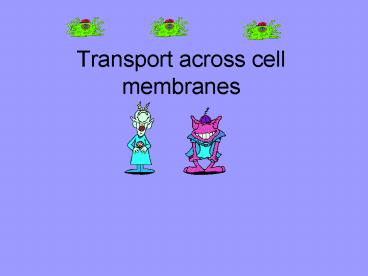Transport across cell membranes - PowerPoint PPT Presentation
1 / 17
Title:
Transport across cell membranes
Description:
Reminder Cell walls are non living, slightly elastic and permeable. Cell membrane (plasma) is semi-permeable. It is made of fats and lipids. – PowerPoint PPT presentation
Number of Views:676
Avg rating:3.0/5.0
Title: Transport across cell membranes
1
Transport across cell membranes
2
Reminder
- Cell walls are non living, slightly elastic and
permeable. - Cell membrane (plasma) is semi-permeable. It is
made of fats and lipids. The fats are arranged
hydrophilic head out. Embedded in the fluid
layer are proteins some are tube like, some
act as receptors, some actively pump molecules,
some are structural.
3
(No Transcript)
4
(No Transcript)
5
- PASSIVE TRANSPORT
6
Diffusion
- Particles are always in motion. The tendency of
particles is to move to fill up a space. In
biology terms, diffusion is the net movement of
molecules from an area of high concentration to
an area of low concentration.
7
- The difference in concentration in the two areas
is the concentration gradient. A large
difference gives a steep gradient and fast
diffusion. - No energy is used to move the molecules.
8
- Rate varies depending on
- size of molecules (smaller faster)
- temperature of liquid or gas (warmerfaster)
- state being diffused (gas faster than liquid)
- concentration of chemical
9
Facilitated Diffusion
- Some proteins in cell membrane help the diffusion
of certain chemicals across the membrane faster
than others glucose is carried faster than many
others. The transport proteins are specialized
to the type of chemical they can carry.
10
(No Transcript)
11
Osmosis
- Net movement of water from hi to low
concentration through a semi-permeable membrane.
(only water!) - A weak solution is hypotonic, a strong solution
is hypertonic and if the same they are isotonic.
12
Osmoregulation
- The control of water in cells is very important
as water passes rapidly across cell membranes.
13
- In plants the vacuole acts as a fluid skeleton
too little and the plant becomes floppy , too
much and it becomes crisp. - Single celled organisms constantly have water
flooding them so use a contractile vacuole to
pump water out. - Freshwater fish can drown due to water flooding
their cells so produce copious amounts of urine. - Saltwater fish either keep their bodies at the
same saltiness as the sea or drink the seawater
and extract salt. - Humans have water-resistant skin, so dont need
to worry!
14
Active transport
- Movement against a concentration gradient from
low to high. This process uses energy we can
tell when energy is used if heat is given off, O2
is used, CO2 is made or glucose is used. If
cells have a large number of mitochondria then it
is likely to have a high energy requirement.
15
Endocytosis and exocytosis
- Some cells can engulf large particles
(endocytosis). If the particle is solid we call
it phagocytosis and if liquid pinocytosis. - Exocytosis is
- the reverse process
- getting rid of waste
- particles or transporting
- materials out of the cell.
16
Cell size
- Cell size is important in diffusion the larger
a cell is the more difficult it is to diffuse
substances in and out. Cells normally grow until
they double their size and then divide. To have
efficient diffusion you need cells to have a high
SA/Vol ratio. This is why cells divide the
volume drops but the surface area increases so
the ratio goes up.
17
(No Transcript)































